1. How many pradakshinas should be performed around a Deity?
Many of us go to the Devalay (Temple) to have a darshan (viewing) of the Deity. In order to take maximum benefit of the darshan, one must do pradakshina (circumambulation) of the Deity. To commence the pradakshina, one can start moving at normal pace from the left side of the garbha-gruha (Sanctum sanctorum) with hands folded in the Namaskar-mudra (Both the hands joined and held at the level of the Anahat-chakra [The fourth centre in the spiritual energy flow system, located in the region of the heart in the subtle-body], but a little away from the body), while chanting the Deity’s Name. After the pradakshina, pay obeisance to the Deity, and only then commence the next pradakshina.
2. Reason for different number of
pradakshinas to be performed around a Deity
The general rule is that, for male Deities, the number of pradakshinas should be in ‘even’ numbers (0, 2, 4, 6), and for female Deities, it should be in odd numbers (1, 3, 5, 7). The reason is as follows. ‘Zero’ denotes Brahman, meaning, Supreme God, who isthe Creator of the universe. From ‘zero’, the number ‘one’, that is, Maya (The Great illusion), meaning, the universe has originated. Maya is feminine, and the number ‘one’ is an ‘odd number’. Hence, pradakshina around the female Deities should be done in ‘odd’ numbers. ‘Even’ numbers are associated with ‘zero’ and hence, pradakshina around the male Deities should be done in ‘even’ numbers.
- A subtle experiment, which proves the mentioned reason
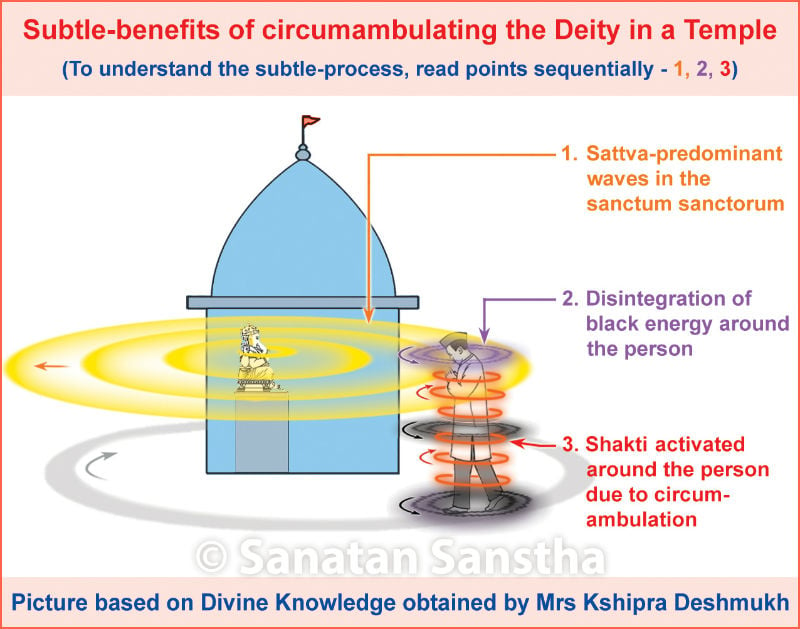
First, chant a number associated with zero (0, 2, 4, 6 etc., that is, even numbers) for two minutes. Then, chant a number associated with one (1, 3, 5, 7 etc., that is, odd numbers) for two minutes. Only after doing this read the following part of the experiment.
The chanting of an even number gives spiritual experience of Anand (Bliss) or Shanti (Serenity), while chanting of an odd number gives spiritual experience of Shakti (Divine Energy). Male Deities are mostly associated with Anand or Shanti, whereas, the female Deities are mostly associated with Shakti. From the experiment here, we can experience, that numbers associated with zero are associated with male Deities, while those associated with number one are associated with female Deities. Hence, pradakshina around male Deities should be performed in even numbers, and around female Deities in odd numbers.
3. Specific number of pradakshinas
associated with each of the Sapta-devtas
There are specific number of pradakshinas prescribed for each of the Sapta-devtas (The seven Deities, namely, Shri Ganesh, Deity Shiva, Shriram, Deity Hanuman, Deity Datta, Shri Durga and Shrikrushna).
According to different schools of thought, the number of times a pradakshina to be performed around each Deity is different. Some examples given here support this statement. The number of pradakshinas change according to sagun (Materialised) &nirgun (Non-materialised), or tarak (Saviour) &– marak (Destroyer) form of the Deity, or as per the intention of the person performing the pradakshina. As per the science of numerology too, the numbers associated with different Names of Deities are different. ‘There are as many Paths to God-realisation as the number of individuals and their respective temperaments’ – this is an important doctrine of Hindu Dharma. According to this doctrine, the number of pradakshinas are not fixed; they vary as per the situation.
The number of pradakshinas mentioned against a Deity’s Name in the table ahead denotes the minimum number required for the respective Deities. Should a larger number be intended, then it should be done in the multiples of the minimum number specified.
A. Method 1 – Subordinate forms of the Deities
| Sapta-devtas | Number of pradakshinas | Reason underlying the number |
|---|---|---|
| Deity Shiva | 0 (Note 1) | Deity symbolic of dormant and unmanifest nirgun energy |
| Goddess Durga | 1 | Deity representing the state of sagun manifest energy in dvait |
| Srikrushna | 3 | Purnavtars working equally at three levels of iccha-shakti, kriya-shakti and dnyan-shakti |
| Sriram | 4 | The king who is an ideal follower of all the four ashrams, that is Brahmancharyashram, Gruhastashram, vanprasthashram and Sanyasashram |
| Deity Maruti | 5 | One who is mastery over Pancha-tattvas |
| Deity Datta | 7 | One who brings about spiritual progress of the jiva by purifying the seven chakras present in the body |
| Sri Ganapati | 8 | Master of all the eight direction |
The rule mentioned here applies to the subordinate forms of these Deities.
Note 1 : Pradakshina of the Shivapindi (Deity Shiva’s sacred symbol): The method of performing the pradakshina around the Shivapindi is ‘Somasutri’, that is, in a crescent shape. The ‘sutra’ (A channel) that passes from the shalunka (Base of the linga [Deity Shiva’s sacred symbol], also known as lingavedi) towards the North side, that is, towards the boundary of the Devalay is called ‘Somasutra’. We begin the pradakshina from the left side and go till the outward projecting channel of the shalunka; then, without crossing it, turn back and come unto the channel from the other side and thus complete one pradakshina. The flow of a shalunka is not crossed, as it is the flow of energy. When crossing it, the legs are spread. As a result, formation of semen and the five vayus (Internal vital air energies) are adversely affected. There is an obstruction in the flow of Devdatta and Dhananjay vital air energies too. However, these ill effects do not occur if while crossing it, the body is contracted, that is the nadis (Energy channel) are contracted.
This law is applicable to man-made Shivalinga; however, this is not applicable to a Swayambhu (Self-originated) linga or to the Shivalinga in the Devalay at home. The way a pradakshina is done in a complete circle in case of other Deities, is not done in the case of the Shivapindi. Hence, the number of pradakshinas advised in case of Deity Shiva is zero.
B. Method 2 – As per the Sattva, Raja and Tama component and nirgun tattva (Principle):
| Deity | Emitted component/tattva (principle) | Color of the suble-waves | Number of Pradakshinas | Effect of Pradakshinas on the jiva |
|---|---|---|---|---|
| Sriram | Pure Sattva (Tarak) | Bluish white | 1 (One who adhers to a single vow) | A. Awakening of Sattvikbhav
B. Experiencing Shanti |
| Srikrushna | Sattva and sattva-Raja | Sattva-predominent waves are yellow in colour, while Sattva-Raja are reddish yellow | 1 or 2 (Either in advait nirgun form or in dvait, this is functioning in the sagun form) | A. Awakening of bhav, love and kshatrabhav
B. Experiencing Anand |
| Deity Datta | Predominantly nirgun-tattva and to some extent Sattva component of the sagun-tattva | White, golden yellow and sometimes faint blue | 3 (Combined form of Brahma, Vishnu and Mahesh) | Nirgun-tattva is not generated by performing pradakshina just once. For that, one has to perform pradakshina thrice. This increases the sattvikbhav of a seeker |
| Deity Maruti | Sattva-Raja, 50% Sriram’s principle and marak-shakti | Saffron and dark blue | 2,5,7,11,13,21,77,99 and 101 | A. Reduction in the desire as caused due to negative energies
B. Increase in enthusiasm (Awakening of kshatrabhav) |
C. Method 3 – As per the Energy and function of the Deity:
एकंदेव्यांरवौसप्त त्रीणिकुर्याद्विनायके ।
चत्वारिकेशवेकुर्यात् शिवेचार्धप्रदक्षिणम् ।। – कर्मलोचन
Meaning : One pradakshina should be performed around the Goddess, seven around Sun Devalay, three around Shri Ganapati, four around Shrivishnu and a half around Shiva Devalay.
Spiritual Science:
-
Shrivishnu: Four pradakshinas have been prescribed for Shrivishnu, because Vishnu Principle contains the Divine energies of four actions of invocation, recitation, songs of praise and protection.
-
Deity Shiva: The Shiva Principle is the symbol of that half part of ‘Om’ which signifies the function of Dissolution. Hence, only half a pradakshina has been prescribed. Half part is the part called ‘Aas’, which remains after utterance of ‘Om’ for its functions. (‘Aas’ are the subtle sound waves that remain after an object is struck on another object. For example, the subtle sound waves which remain in the environment when the bell in a Devalay is sounded. These subtle sound waves are called ‘Aas’.)
-
Goddess: ‘Full stop’ means the point where the ‘Aas’ gets dissolved immediately after it manifests. In other words, it is the line which denotes the function of the ‘full stop’. Hence, only one pradakshina of the Devalay of the Goddess has been prescribed.
-
The Sun: When the Tej dharana (Energy of the radiance of the Sun) comes in the orbit of the Earth from the Sun, it intercepts seven levels and transforms at the sagun level through the medium of Vayu-Tej , Tej-Vayu, Tej, Tej-Apa, Apa-Tej, Tej-Pruthvi and Pruthvi-Tej Principles. As a symbol of this, 7 pradakshinas are performed. (Note : Vayu = Absolute Air, Tej = Absolute Fire, Aap = Absolute Air, Pruthvi = Absolute Earth)
-
Shri Ganapati: Shri Ganapati is the symbol of Ichha-shakti (Energy of will). The waves of Ichha-shakti are attracted to a triangular figure in a shorter time. As a symbol of the union of the three flows, three pradakshinas of Shri Ganapati are performed.
D. Method 4 – Performing pradakshinas according to Sankhya shastra (Science of numerology)
- Deity Shiva – 3
- Shrikrushna – 8
- Shriram – 9
- Shri Ganapati – 3
4. How many pradakshinas should be
performed around a Swayambhu Devalay
Since the activated energy in a Swayambhu Devalay cannot be imbibed by a common man, only one pradakshina is sufficient. An individual with over 50% spiritual level can make as many pradakshinas as he wants as per his bhav (Spiritual emotion). There is no limit to the number of pradakshinas for him.
Reference : Sanatan’s Holy Text, How should one have darshan in a temple?

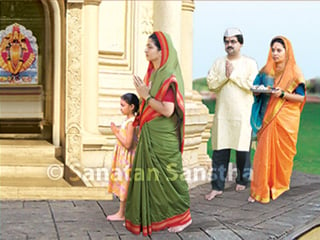
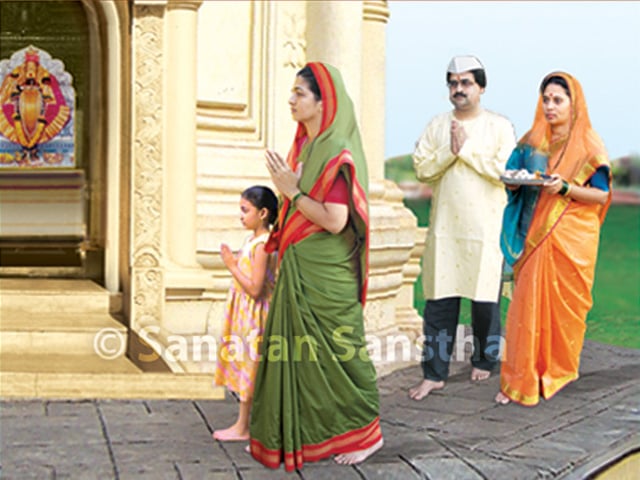
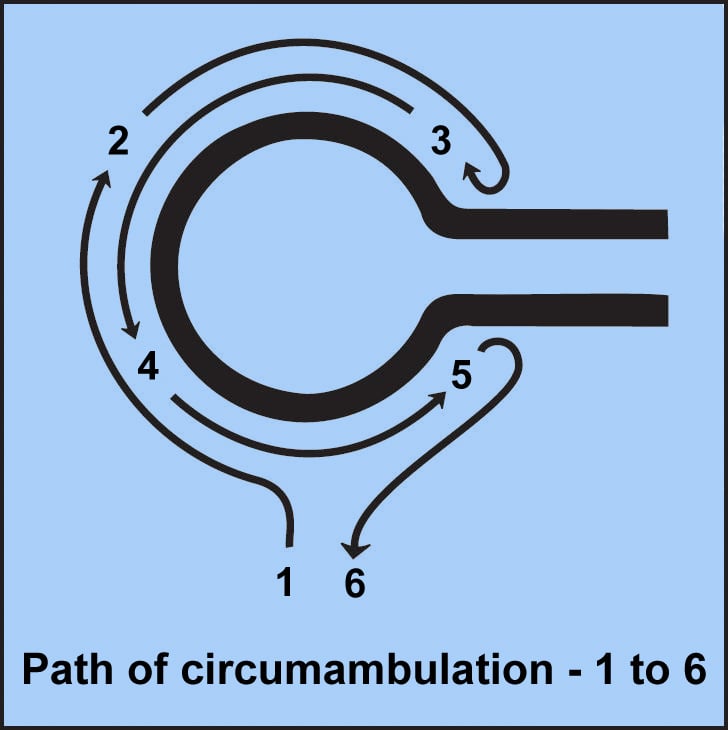
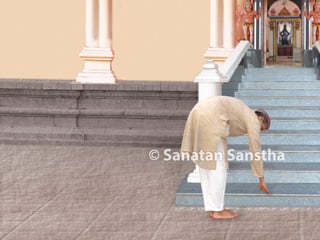 The correct method of having darshan in a Devalay (Temple)
The correct method of having darshan in a Devalay (Temple)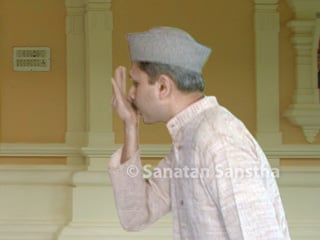 Partaking Tirth and Prasad
Partaking Tirth and Prasad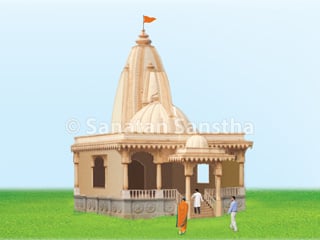 Importance of having darshan in a Devalay (Temple)
Importance of having darshan in a Devalay (Temple)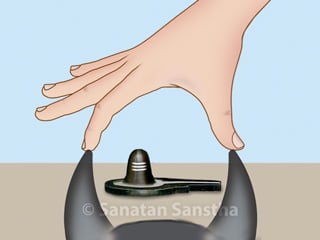 Importance of taking darshan of Nandi before darshan of the pindi in Deity Shiva’s Devalay
Importance of taking darshan of Nandi before darshan of the pindi in Deity Shiva’s Devalay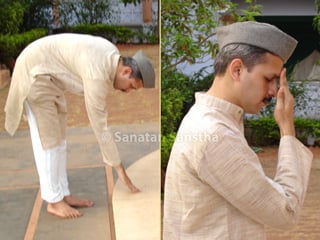 Visiting a Hindu temple - How to take benefits spiritually
Visiting a Hindu temple - How to take benefits spiritually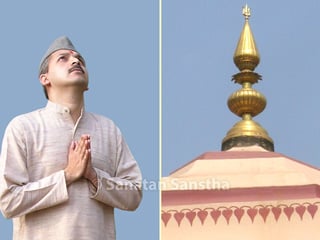 Taking darshan of the kalash (Dome) of the Devalay
Taking darshan of the kalash (Dome) of the Devalay